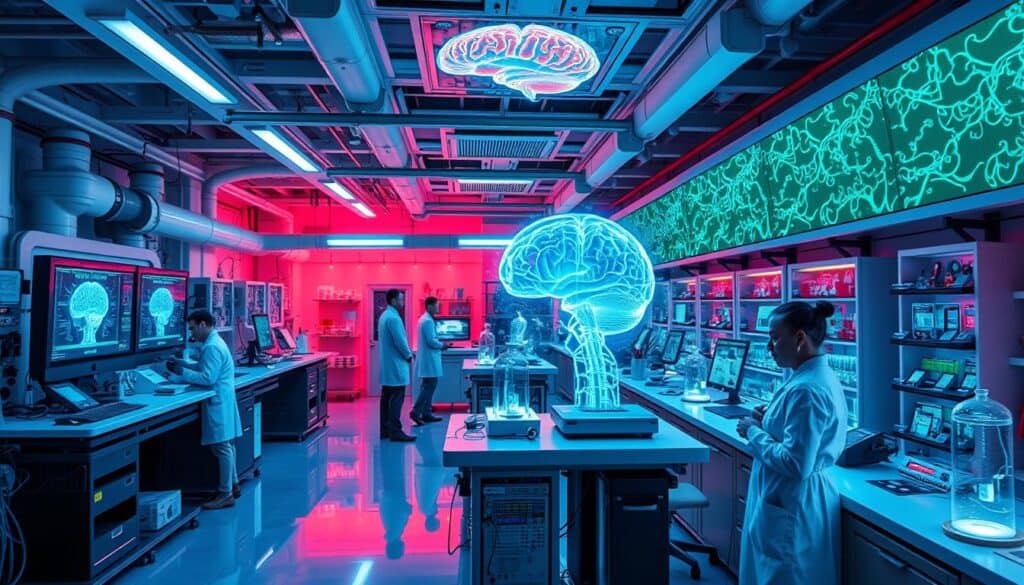Did you know that in 2025, biotechnology research funding is expected to hit $9,137 million? This huge investment shows the importance of الهندسة العصبية. It combines many scientific fields to improve how we understand and control neural activities. This field is not only about getting funds. It’s about making big strides in brain-computer connections, changing treatments for brain disorders, and how we interact with machines.
Neural engineering is leading the way in medical research by merging bio-engineering, brain science, and digital tech. In 2025, this field is pushing the limits of our knowledge and capabilities. For example, a few patients have received مؤشرات BCI directly implanted into their brains. But, over 160,000 people have used deep brain stimulation devices to handle brain conditions.
النقاط الرئيسية
- Neural engineering in 2025 benefits from significant funding across various research domains, including biotechnology and bioengineering.
- Brain-computer interfaces and neuromodulation techniques are at the forefront of current research trends.
- Noninvasive BCIs using EEG are emerging technologies with promise, facing challenges in signal extraction.
- Institutions like Harvard are actively seeking experts in the field to drive forward innovative research.
- Advancements in artificial intelligence and machine learning are set to enhance BCI performance and reliability.
Overview of Neural Engineering in 2025
Neural engineering in 2025 stands at the crossroads of innovation and major healthcare advancements. It combines computer science, electrical engineering, and more to make devices that work with brain tissue. The field’s wide applications, like brain-computer links, neuroimaging, and robot-assisted motion, highlight its game-changing potential.
Definition and Scope
Neural engineering uses engineering to understand and improve the nervous system. It helps fix severe issues like strokes and brain injuries and enhances the control over robots. This field is making strides in turning brain activity into tech solutions, improving how we move and perceive the world.
Historical Context and Evolution
The field of neural engineering has grown from basic neuromodulation devices to complex brain-computer links. A key focus now is on making tissues that can heal nerves. Animal studies have been crucial for grasping human brain pathways, setting the stage for today’s neural engineering feats in 2025.
Also, lasting neural recording systems have changed how we view and control neural signals. Devices that help restore movement after strokes showcase the field’s real-world impact. And the field keeps growing, holding promise for new ways to augment human abilities.
| الحقل | التطبيق | التأثير |
|---|---|---|
| واجهات الدماغ والحاسوب | Control الروبوتية devices, improve neuroprostheses | Expanded human-technology interaction |
| Neuroimaging | Advanced brain mapping techniques | Better understanding of brain functions |
| Neural Tissue Engineering | Nerve repair and regeneration | Improved recovery post-neural injuries |
| Neurorobotics | Enhanced robotic limb control | Improved quality of life for amputees |
Current Trends in Neural Engineering Research
In 2025, neural engineering is making big strides in science and tech. It’s all about new breakthroughs that mix different fields of study. We’re seeing better neural interfaces, brain-computer setups, and new ways to change nerve activity. These advancements are changing medicine and deepening our knowledge of the brain and nerves.
Neural Interfaces and Brain-Computer Interfaces
Right now, neural interfaces and brain-computer interfaces (BCIs) are leading the way. They’ve gotten better thanks to new materials and building techniques. This means they’re less invasive and work better with our neurological systems. BCIs are especially important for helping people with severe movement issues communicate and control devices.
Neuromodulation and Neuroprostheses
Neuromodulation and neuroprosthetics are getting a lot of attention too. Techniques like deep brain stimulation help with Parkinson’s and epilepsy. Neuroprosthetics are improving or replacing nervous system functions. The focus is on precise control and making them fit each patient better. This could lead to better health outcomes and more options for treatment.
Emerging Technologies and Innovations
Linking neural engineering with AI and machine learning is a big trend. This makes neural devices smarter and able to adjust on their own. They offer better feedback and can process data in real-time. Exciting work with nanotech and CRISPR-Cas9 also shows where we could be headed next. These could change how we diagnose and treat neurological ailments.
Moreover, there’s work on sophisticated neural interfaces that mesh well with our bodies. This points to a research field that’s always looking forward. It’s a hopeful sign that neural engineering could transform health care and boost human abilities.
Key Companies Leading Neural Engineering in 2025
In 2025, established companies and innovative startups are making big strides in neural engineering. They are focusing on neural interfaces, neuromodulation, and neuroprostheses. Their work is changing how we think about the future of these technologies.
Main Players in the Market
Big companies have been leading the charge in neural engineering. They’re innovating and developing new technologies:
- Boston Scientific: they are leaders in creating minimally invasive devices. Their Greenlight system treats benign prostate hyperplasia effectively.
- Medtronic: investing heavily in R&D, Medtronic makes devices like cardiac pacemakers and neurostimulation systems. They focus on advanced tools that require less invasive surgeries.
- GE Healthcare: they specialize in diagnostic imaging like MRI, CT, and ultrasound. GE Healthcare is dedicated to improving patient care with these technologies.
- Abbott: known for their diagnostic products, Abbott is improving the management of diabetes, heart conditions, and more. Their work significantly impacts healthcare technology.
- Stryker: Stryker is advancing surgical procedures and orthopedic treatments. They design medical devices that support these improvements.

Startups and New Entrants
New companies are also bringing fresh ideas to neural engineering. They’re developing new solutions and getting the funding they need:
- Blackrock Neurotech: they got $200 million from Tether in April 2024. Blackrock is making big advancements in neural interfaces.
- Verge Genomics: with $134.1 million in Series B funding, they’re tackling neurodegenerative diseases. This makes them a key player in neural engineering.
- Ceribell: they’ve seen an impressive growth rate over five years. Ceribell is maintaining its growth in the neural engineering field.
- Neuralink: valued at $5 billion after getting $280 million in funding. Neuralink is working on brain-machine interfaces that could change neural engineering.
- Hippoc: this Montreal startup got $3 million in seed funding. They’re mixing neuroscience and AI for groundbreaking innovations.
The global neuroscience market is expected to hit $721 billion by 2026. A 4.2% growth rate is fueling this trend. With continued investments, we’ll see more jobs and innovations in neural engineering.
The biomedical engineering field is قاد by companies like Boston Scientific and Medtronic. They’re at the forefront of medical tech advancements. These companies are key to better healthcare through new devices and technologies.
| الشركة | Notable Achievement |
|---|---|
| Blackrock Neurotech | Raised $200M from Tether; majority stake acquisition |
| Verge Genomics | Secured $134.1M Series B funding |
| Ceribell | 7,592% search growth rate over five years |
| Neuralink | $5B valuation... |
You have read 36% of the article. The rest is for our community. Already a member? تسجيل الدخول
(وأيضًا لحماية المحتوى الأصلي لدينا من روبوتات الكشط)
مجتمع الابتكار العالمي
تسجيل الدخول أو التسجيل (100% مجاناً)
اطلع على بقية هذه المقالة وجميع المحتويات والأدوات الخاصة بالأعضاء فقط.
فقط المهندسون والمصنعون والمصممون والمسوقون الحقيقيون المحترفون.
لا روبوت، ولا كاره، ولا مرسل رسائل غير مرغوب فيها.
التعليمات
What is the current status of neural engineering research and applications in 2025?
In 2025, neural engineering is leading the way in medical science. It combines bioengineering, brain studies, and digital tech. The goal is to understand and control how the brain works. This area works on fixing nervous system problems and improving how humans and machines interact. It uses new materials science and tiny manufacturing technologies.
How has neural engineering evolved historically?
Neural engineering has grown from simple devices to advanced brain-computer links. It now works to improve and restore human abilities. This is done by turning brain activity into useful actions and back. It uses expertise from computer brain studies, electrical studies, and other fields.
What are the current trends in neural engineering research?
The latest trends in this field include better neural links and computer-brain interfaces, new ways to control brain activity, artificial limbs, and cutting-edge technology in materials and tiny manufacturing. These improvements aim for less invasive, more effective ways to connect with the human brain.
Who are the key companies leading neural engineering in 2025?
Both big companies and new startups are key players in neural engineering. Big firms push forward research on neural links. Startups bring new ideas and get venture capital to make a mark in the sector.
What are the practical applications of neural engineering in 2025?
Neural engineering has many uses, from medical treatments for diseases like Parkinson’s and epilepsy to non-medical purposes. It helps improve how we process information and interact with digital worlds. These uses show its تعدد الاستخدامات and huge potential.
What future advancements are expected in neural engineering?
Future breakthroughs in neural engineering will change how we interact with technology. Expect better brain-computer interfaces and devices that can adjust brain activity. These will make the line between human thought and machines even fuzzier.
What opportunities exist for careers in neural engineering?
There are many job chances in neural engineering, in academic research, and tech companies focused on learning machines and smart intelligence. Many universities now offer special courses and degrees. They are often supported by grants from big science funds.
How does neural engineering impact healthcare in 2025?
Neural engineering is improving healthcare with better diagnosis and care through advanced biotechnologies and treatments. It’s driving innovation, creating jobs, and opening new markets. But it also brings up big ethical questions about human enhancement.
What are the main challenges and ethical considerations in neural engineering?
This field faces big challenges, including ethical issues about privacy, agreeing to treatment, and the line between making people better and therapy. The complexity of the brain makes finding effective treatments hard. This requires teamwork across many fields and careful rules.
Glossary of Terms Used
Brain-Computer Interface (BCI): نظام يُمكّن من التواصل المباشر بين الدماغ والأجهزة الخارجية، مما يسمح بالتحكم في التكنولوجيا من خلال النشاط العصبي. يتضمن هذا عادةً التقاط الإشارات ومعالجتها وترجمتها إلى أوامر لتطبيقات مثل الأجهزة المساعدة أو الأطراف الاصطناعية العصبية.
Computed Tomography (CT): تقنية تصوير طبي تستخدم الأشعة السينية والمعالجة الحاسوبية لإنشاء صور مقطعية للجسم، مما يتيح تصورًا دقيقًا للهياكل والأنسجة الداخلية. تُعزز هذه التقنية قدرات التشخيص من خلال توفير صور ثلاثية الأبعاد من بيانات ثنائية الأبعاد.
Institute of Electrical and Electronics Engineers (IEEE): جمعية مهنية تُعنى بتطوير التكنولوجيا في الهندسة الكهربائية والإلكترونيات وعلوم الحاسوب والمجالات ذات الصلة من خلال المنشورات والمؤتمرات وتطوير المعايير. وتشجع الجمعية الابتكار والتعاون بين المهنيين والباحثين حول العالم.
Magnetic Resonance Imaging (MRI): تقنية تصوير طبي تستخدم مجالات مغناطيسية قوية وموجات راديوية لتوليد صور مفصلة للهياكل الداخلية للجسم، وخاصة الأنسجة الرخوة، من خلال اكتشاف الإشارات المنبعثة من نوى الهيدروجين في وجود مجال مغناطيسي.
Radiology Information System (RIS): نظام برمجي لإدارة بيانات التصوير الطبي، وتسهيل جدولة الإجراءات الإشعاعية وتتبعها وإعداد التقارير عنها، والتكامل مع أنظمة الرعاية الصحية الأخرى لتحسين سير العمل ورعاية المرضى.
Robotic Process Automation (RPA): تقنية تستخدم الروبوتات البرمجية لأتمتة المهام المتكررة والمبنية على القواعد في العمليات التجارية، مما يتيح زيادة الكفاءة والدقة والإنتاجية من خلال محاكاة التفاعلات البشرية مع الأنظمة الرقمية.
Spiking Neural Network (SNN): a computational model that mimics biological neural networks by processing information through discrete spikes or action potentials, enabling temporal coding and event-driven processing. SNNs are used in neuromorphic computing and are characterized by their ability to learn from time-dependent data.











It’s fascinating to see neural engineering pushing both medical and non-medical boundaries
the article could delve deeper into the societal implications of these technologies, such as potential shifts in employment
It would be interesting to explore ethical considerations and potential risks associated with these
منشورات ذات صلة
استراتيجية مكافحة التلوث والغرف النظيفة: 26 أفضل الممارسات
من GMP إلى cGMP: دليل الإتقان الكامل
التحقق من صحة عملية IQ OQ PQ: النظرية الكاملة والتطبيق العملي
استراتيجيات "الجوز الوحيد"، و"التابع الأول"، و"التابع السريع"
أفضل 20 استخدامًا للوكلاء في الهندسة
كيفية بيع الثلج للإسكيمو (أو بالأحرى حيل التسويق)